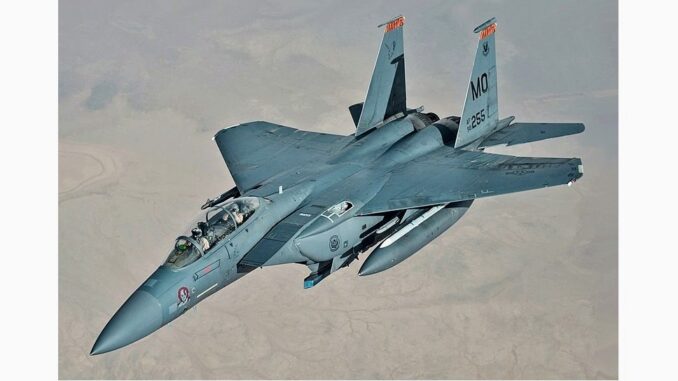
After a months-long buildup of coalition forces in the region, Operation Desert Storm (a.k.a. the first Gulf War) began on 17 January 1991, continuing for just five and a half weeks. Air strikes against Iraqi targets by the coalition dominated the news in the first three weeks of action. A principle concern was the Iraqi threat of firing Scud missiles against Israel and Saudi Arabia, with considerable resources invested in finding the Scuds and destroying them. Special Forces teams were inserted behind Iraqi lines to search out the Scuds and report their location, followed by a prompt bombing attack by coalition war planes before the big ballistic missiles could launch. The McDonnell Douglas F-15E Strike Eagle was one type of aircraft assigned to this role.
Strike Eagles are two-seat versions of the iconic F-15 Eagle, a single-seat air superiority fighter designed primarily for combat against enemy fighter aircraft. The Strike Eagle is capable of air-to-air combat, but its primary job is in the air-to-ground attack role. Earlier generations of this type of aircraft were sometimes called fighter bombers. In addition to the pilot, the second seat is occupied by the weapon systems officer (WSO, pronounced wizzo) who operates the systems that were added to the F-15 to give it ground attack capability; electronic warfare equipment, targeting, thermographic cameras, radar, and navigation. The WSO also assists the pilot with other tasks during a mission.
In the early morning hours of 14 February 1991, USAF Captain Richard T. Bennett, (pilot) and Captain Daniel B. Bakke, (WSO), were flying a combat air patrol sortie in northwestern Iraq, looking for Scuds. Their Strike Eagle was armed with four GBU-10s (2,000-pound laser guided bombs) and four AIM-9 air-to-air missiles (for defense in case they were attacked by MiGs). Their wingman, also a Strike Eagle, carried twelve Mk. 82 bombs and four AIM-9s. While searching for Scud mobile launchers with infrared cameras, they got a call over the radio from AWACS (Airborne Warning and Control System). A special forces team nearby had been spotted by Iraqi forces. Outnumbered and outgunned they were in dire need of air support. Bennet and his wingman throttled forward to their position. Anti-aircraft fire from the ground was thick. Bennet’s unit had already lost a couple of Strike Eagles and their aircrews to AA, but there was no time to think about the danger. As they neared the ground battle, AWACS confirmed there were five large Iraqi helicopters, probably Soviet-made Mi-24 Hinds flying low. Bennet and Bakke could see the Hinds dropping off troops here and there, setting up a trap for the special forces team. Next time the Hinds landed, Bennet dropped a laser guided bomb from four miles away, while Bakke kept a laser targeted on the lead Hind. Before the bomb reached the target, the Hind lifted off again. Bennet was sure the bomb would hit the ground rather than the Hind, so he prepared an AIM-9 to shoot it down. But Bakke never let the laser slip off the Hind, and the laser-guided bomb, meant for ground targets, hit the Hind in mid-air. Iraqi forces scattered and the special forces team were safe. Thirty years later, it’s still the only air-to-air kill made by a Strike Eagle and it was done with a bomb rather than a missile. An improbable air-to-air kill that likely will never be duplicated.
“How an F-15E scored an air to air kill with a bomb” (12:57)
